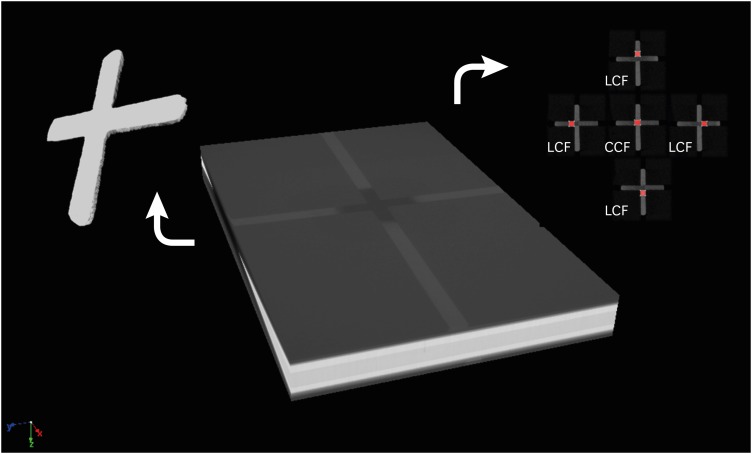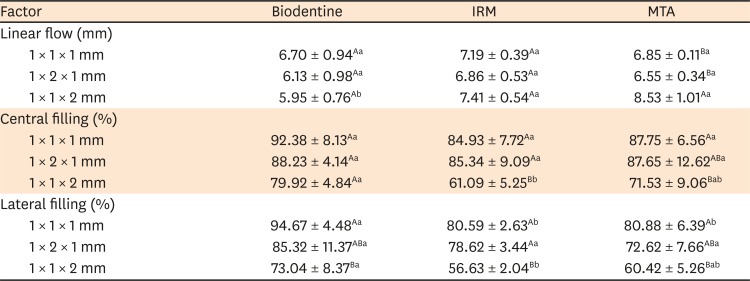1. Adl A, Sadat Shojaee N, Pourhatami N. Evaluation of the dislodgement resistance of a new pozzolan-based cement (EndoSeal MTA) compared to ProRoot MTA and Biodentine in the presence and absence of blood. Scanning. 2019; 2019:3863069. PMID:
31210836.

2. Küçükkaya Eren S, Aksel H, Serper A. Effect of placement technique on the push-out bond strength of calcium-silicate based cements. Dent Mater J. 2016; 35:742–747. PMID:
27546860.
3. Parirokh M, Torabinejad M. Mineral trioxide aggregate: a comprehensive literature review--Part I: chemical, physical, and antibacterial properties. J Endod. 2010; 36:16–27. PMID:
20003930.

4. Alcalde MP, Vivan RR, Marciano MA, Duque JA, Fernandes SL, Rosseto MB, Duarte MA. Effect of ultrasonic agitation on push-out bond strength and adaptation of root-end filling materials. Restor Dent Endod. 2018; 43:e23. PMID:
29765903.

5. Küçükkaya Eren S, Parashos P. Adaptation of mineral trioxide aggregate to dentine walls compared with other root-end filling materials: a systematic review. Aust Endod J. 2019; 45:111–121. PMID:
29450937.

6. Saxena P, Gupta SK, Newaskar V. Biocompatibility of root-end filling materials: recent update. Restor Dent Endod. 2013; 38:119–127. PMID:
24010077.

7. Akbulut MB, Arpaci PU, Eldeniz AU. Effects of four novel root-end filling materials on the viability of periodontal ligament fibroblasts. Restor Dent Endod. 2018; 43:e24. PMID:
30135845.

8. Kohli MR, Berenji H, Setzer FC, Lee SM, Karabucak B. Outcome of endodontic surgery: a meta-analysis of the literature-part 3: comparison of endodontic microsurgical techniques with 2 different root-end filling materials. J Endod. 2018; 44:923–931. PMID:
29681480.

9. Al-Haddad A, Abu Kasim NH, Che Ab Aziz ZA. Interfacial adaptation and thickness of bioceramic-based root canal sealers. Dent Mater J. 2015; 34:516–521. PMID:
26235718.

10. Song YS, Choi Y, Lim MJ, Yu MK, Hong CU, Lee KW, Min KS.
In vitro evaluation of a newly produced resin-based endodontic sealer. Restor Dent Endod. 2016; 41:189–195. PMID:
27508160.
11. Almeida JF, Gomes BP, Ferraz CC, Souza-Filho FJ, Zaia AA. Filling of artificial lateral canals and microleakage and flow of five endodontic sealers. Int Endod J. 2007; 40:692–699. PMID:
17608677.

12. Tanomaru-Filho M, Torres FF, Bosso-Martelo R, Chávez-Andrade GM, Bonetti-Filho I, Guerreiro-Tanomaru JM. A novel model for evaluating the flow of endodontic materials using micro-computed tomography. J Endod. 2017; 43:796–800. PMID:
28268019.

13. International Organization for Standardization. ISO 6876: Dental root canal sealing materials. Geneva: International Organization for Standardization;2012.
14. Kim K, Kim DV, Kim SY, Yang S. A micro-computed tomographic study of remaining filling materials of two bioceramic sealers and epoxy resin sealer after retreatment. Restor Dent Endod. 2019; 44:e18. PMID:
31149616.

15. Jang JH, Lee HW, Cho KM, Shin HW, Kang MK, Park SH, Kim E.
In vitro characterization of human dental pulp stem cells isolated by three different methods. Restor Dent Endod. 2016; 41:283–295. PMID:
27847750.
16. Duarte MA, Ordinola-Zapata R, Bernardes RA, Bramante CM, Bernardineli N, Garcia RB, de Moraes IG. Influence of calcium hydroxide association on the physical properties of AH Plus. J Endod. 2010; 36:1048–1051. PMID:
20478463.

17. Kim J, Song YS, Min KS, Kim SH, Koh JT, Lee BN, Chang HS, Hwang IN, Oh WM, Hwang YC. Evaluation of reparative dentin formation of ProRoot MTA, Biodentine and BioAggregate using micro-CT and immunohistochemistry. Restor Dent Endod. 2016; 41:29–36. PMID:
26877988.

18. Oltra E, Cox TC, LaCourse MR, Johnson JD, Paranjpe A. Retreatability of two endodontic sealers, EndoSequence BC Sealer and AH Plus: a micro-computed tomographic comparison. Restor Dent Endod. 2017; 42:19–26. PMID:
28194360.

19. Torres FF, Guerreiro-Tanomaru JM, Bosso-Martelo R, Chavez-Andrade GM, Tanomaru Filho M. Solubility, porosity and fluid uptake of calcium silicate-based cements. J Appl Oral Sci. 2018; 26:e20170465. PMID:
29791569.

20. Torres FF, Guerreiro-Tanomaru JM, Bosso-Martelo R, Espir CG, Camilleri J, Tanomaru-Filho M. Solubility, porosity, dimensional and volumetric change of endodontic sealers. Braz Dent J. 2019; 30:368–373. PMID:
31340227.

21. Yanpiset K, Banomyong D, Chotvorrarak K, Srisatjaluk RL. Bacterial leakage and micro-computed tomography evaluation in round-shaped canals obturated with bioceramic cone and sealer using matched single cone technique. Restor Dent Endod. 2018; 43:e30. PMID:
30135849.

22. Peralta SL, Leles SB, Dutra AL, Guimarães VB, Piva E, Lund RG. Evaluation of physical-mechanical properties, antibacterial effect, and cytotoxicity of temporary restorative materials. J Appl Oral Sci. 2018; 26:e20170562. PMID:
30133673.

23. Tsesis I, Elbahary S, Venezia NB, Rosen E. Bacterial colonization in the apical part of extracted human teeth following root-end resection and filling: a confocal laser scanning microscopy study. Clin Oral Investig. 2018; 22:267–274.

24. Aksel H, Küçükkaya Eren S, Askerbeyli Õrs S, Karaismailoğlu E. Surface and vertical dimensional changes of mineral trioxide aggregate and biodentine in different environmental conditions. J Appl Oral Sci. 2018; 27:e20180093. PMID:
30540071.

25. Biočanin V, Antonijević Đ, Poštić S, Ilić D, Vuković Z, Milić M, Fan Y, Li Z, Brković B, Đurić M. Marginal gaps between 2 calcium silicate and glass ionomer cements and apical root dentin. J Endod. 2018; 44:816–821. PMID:
29336880.

26. Akbulut MB, Bozkurt DA, Terlemez A, Akman M. The push-out bond strength of BIOfactor mineral trioxide aggregate, a novel root repair material. Restor Dent Endod. 2019; 44:e5. PMID:
30834227.

27. Küçükkaya Eren S, Aksel H, Askerbeyli Örs S, Serper A, Koçak Y, Ocak M, Çelik HH. Obturation quality of calcium silicate-based cements placed with different techniques in teeth with perforating internal root resorption: a micro-computed tomographic study. Clin Oral Investig. 2019; 23:805–811.

28. Torres FF, Bosso-Martelo R, Espir CG, Cirelli JA, Guerreiro-Tanomaru JM, Tanomaru-Filho M. Evaluation of physicochemical properties of root-end filling materials using conventional and Micro-CT tests. J Appl Oral Sci. 2017; 25:374–380. PMID:
28877275.

29. Tang JJ, Shen ZS, Qin W, Lin Z. A comparison of the sealing abilities between Biodentine and MTA as root-end filling materials and their effects on bone healing in dogs after periradicular surgery. J Appl Oral Sci. 2019; 27:e20180693. PMID:
31596370.

30. Yilmaz A, Helvacioglu-Yigit D, Gur C, Ersev H, Kiziltas Sendur G, Avcu E, Baydemir C, Abbott PV. Evaluation of dentin defect formation during retreatment with hand and rotary instruments: a micro-CT study. Scanning. 2017; 2017:4868603. PMID:
29109814.

31. Camilleri J, Sorrentino F, Damidot D. Investigation of the hydration and bioactivity of radiopacified tricalcium silicate cement, Biodentine and MTA Angelus. Dent Mater. 2013; 29:580–593. PMID:
23537569.

32. Ber BS, Hatton JF, Stewart GP. Chemical modification of proroot mta to improve handling characteristics and decrease setting time. J Endod. 2007; 33:1231–1234. PMID:
17889696.

33. Hsieh SC, Teng NC, Lin YC, Lee PY, Ji DY, Chen CC, Ke ES, Lee SY, Yang JC. A novel accelerator for improving the handling properties of dental filling materials. J Endod. 2009; 35:1292–1295. PMID:
19720234.

34. Duarte MA, Alves de Aguiar K, Zeferino MA, Vivan RR, Ordinola-Zapata R, Tanomaru-Filho M, Weckwerth PH, Kuga MC. Evaluation of the propylene glycol association on some physical and chemical properties of mineral trioxide aggregate. Int Endod J. 2012; 45:565–570. PMID:
22720325.

35. Brichko J, Burrow MF, Parashos P. Design variability of the push-out bond test in endodontic research: a systematic review. J Endod. 2018; 44:1237–1245. PMID:
29935874.










 PDF
PDF Citation
Citation Print
Print



 XML Download
XML Download